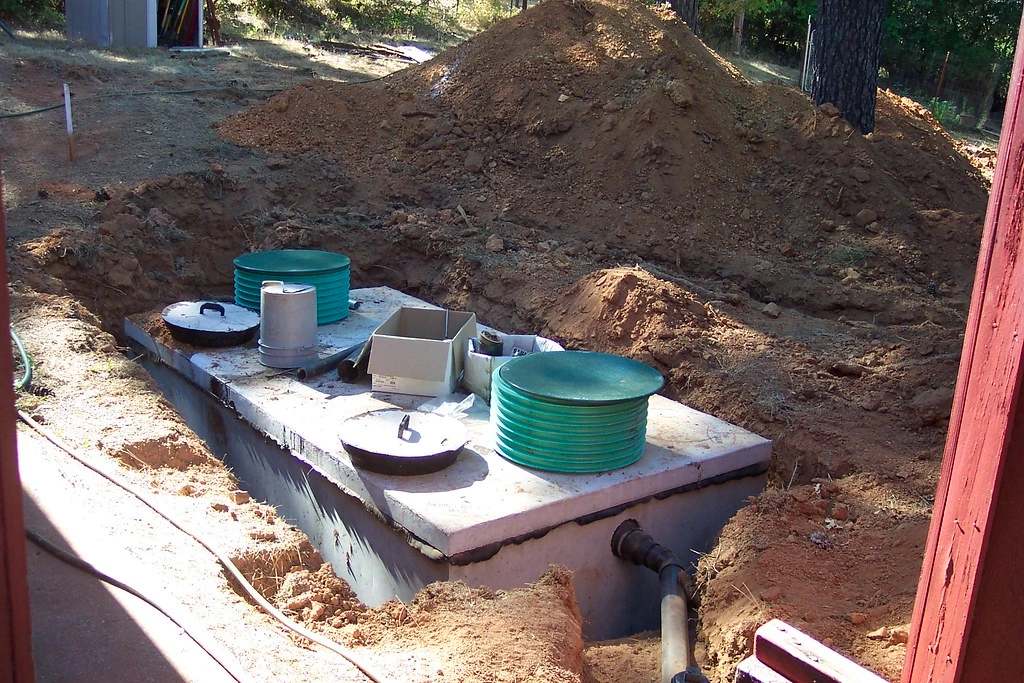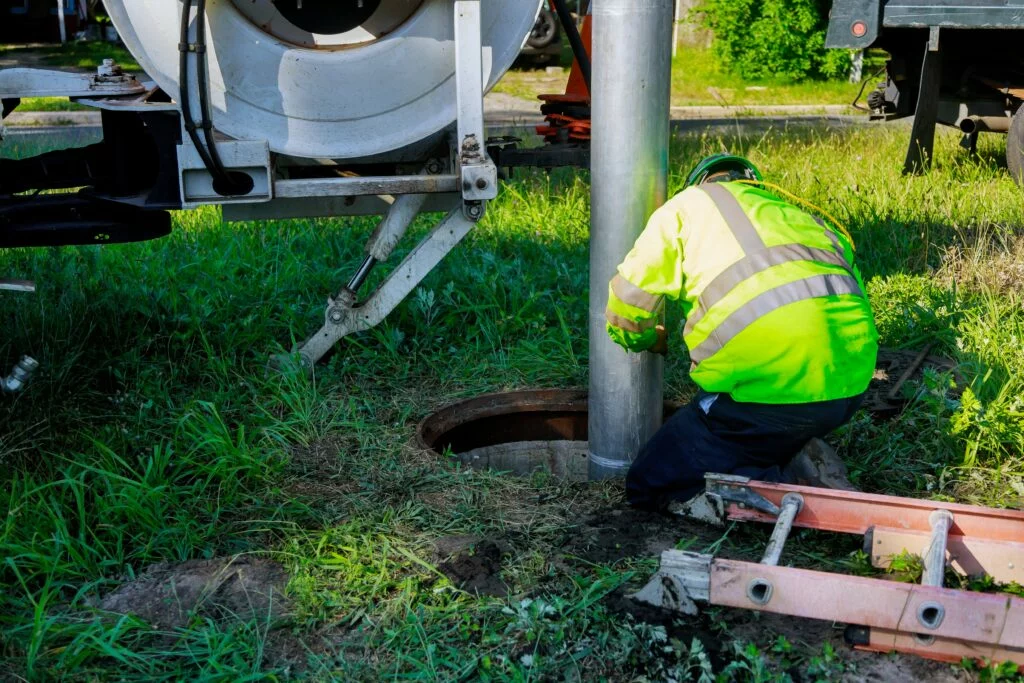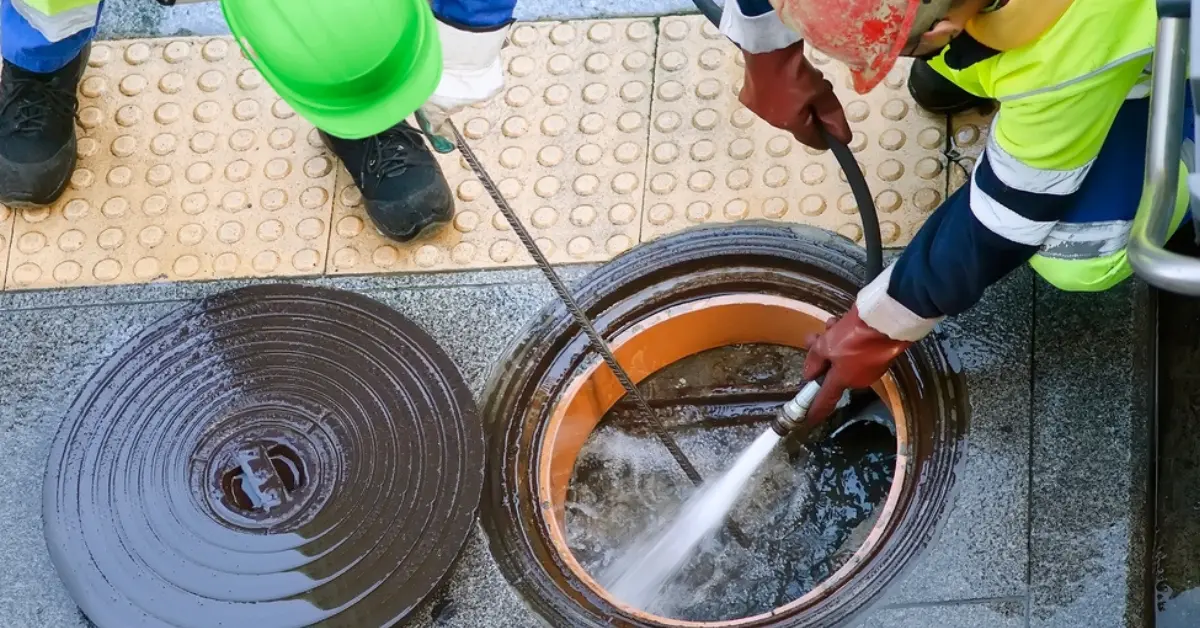Most homes need to pump their septic tank every 3–5 years and have it inspected every 1–3 years, depending on how many people live in the house and the tank size. Special systems, like aerobic or electric tanks, usually need checks every year.
Knowing how often to pump septic tank keeps your home safe and prevents messy backups. If you skip inspections or pumping, you could face slow drains, bad smells, or costly repairs. Even small steps, like tracking when your tank was last checked, can save time and money. It’s better to plan ahead than wait for problems to pop up.
In this guide, you’ll learn how septic systems work, how to tell when yours needs pumping, and how to calculate your personal schedule. We’ll also touch on costs, maintenance tips, and how to choose a reliable local pro like Sewer Tech LI, trusted by Long Island homeowners for years.
Quick answer box / TL;DR
Most septic tanks should be pumped every 3 to 5 years.
That’s the general rule recommended by the EPA and most septic professionals. The exact frequency depends on your tank size, household size, and water use.
- Small households (1–2 people): every 5–6 years
- Average family (3–4 people): every 3–4 years
- Large household (5+ people): every 2–3 years
If you use a garbage disposal, have a smaller tank, or high water use, pump more often.
How a Septic System Works
Do you know where everything goes after you flush or pull the sink plug? It doesn’t just disappear. Beneath your yard sits your home’s own little wastewater treatment system, quietly handling the dirty work every day.
All the drains in your house connect to one main pipe that leads into the septic tank. This big, watertight container is buried underground, and once the water gets there, it naturally separates into layers:
- Sludge, the heavy stuff, sinks to the bottom.
- Scum, made up of oils and grease, floats to the top.
- In the middle is the effluent, or partially treated water.
That liquid slowly flows out through pipes into the drain field, also called the leach field. The soil acts like a natural filter, trapping bacteria and nutrients while letting clean water seep back into the ground.
It’s a simple, self-contained system that works beautifully as long as you don’t ignore it. Over time, the sludge and scum build up. If they’re not pumped out, they can clog pipes or flood the drain field. That’s when small problems turn into expensive ones.
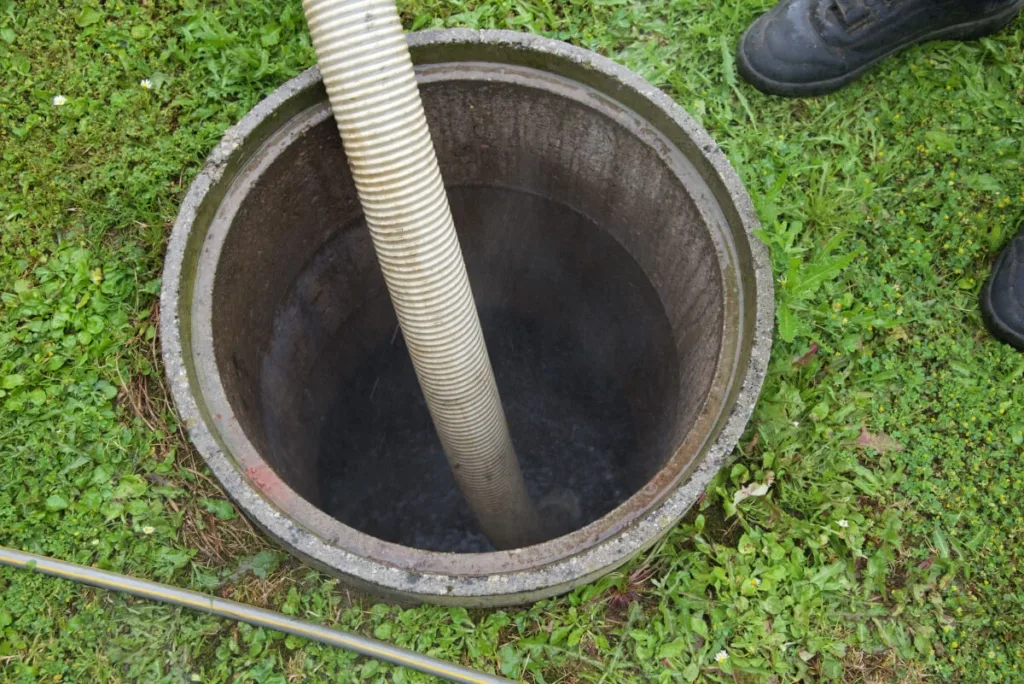
Standard Frequency Rules
The EPA gives us a solid game plan. First, think of inspections as your system’s annual physical. Pros suggest getting one every 1 to 3 years. It’s a small check-up that can spot big problems early.
Now, for pumping. You’ve probably heard the 3-to-5-year rule. That’s the sweet spot for many homes. But your mileage may vary! Your actual schedule depends heavily on who lives in your house and the size of your tank.
| Tank Size (gallons) | Household Size | Typical Pumping Interval |
| 750–1,000 | 1–2 people | 5–6 years |
| 1,000 | 3–4 people | ~3 years |
| 1,250–1,500 | 4–5 people | 2–3 years |
| 1,500+ | 5+ people | 1–2 years |
Here’s a key exception. Got a fancy aerobic system with electrical parts? Those need more attention. Many require a professional look every single year to keep all those moving parts in check.
Think of these rules as your reliable starting point. The final say comes from a pro who can peek inside your tank and give you the all-clear. A little regular care saves you a world of trouble down the line.
Factors That Affect How Often to Pump a Septic Tank
First Up: Who’s Living in Your House?
Just count heads! More people in your home means more showers, more laundry loads, and yes – way more toilet flushes. That big family with three teenagers? They’re probably pumping every couple years. The retired couple down the street? They might stretch it to five or six. It’s simple math – more people equals more… well, you know.
What Size Tank Do You Have?
This is like knowing what size garbage you can have out back. A bigger one doesn’t need emptying as often! Most homes have either 1,000 or 1,500 gallon tanks. Not sure what you’ve got? Check your home inspection papers – it’s probably buried in there somewhere.
What’s Going Down Your Drains?
Let’s get real about three trouble areas:
- Your Garbage Disposal: We all know it’s convenient, but think of it as sending extra “food sludge” straight to your tank. Use it daily? You’ll be pumping more often and may need occasional drain cleaning to prevent buildup.
- “Flushable” Wipes: Can we be honest? There’s no such thing as a septic-safe wipe. They just don’t break down like toilet paper — and that can cause clogs detected during camera inspections.
- Cleaning Products: All that bleach and antibacterial soap? It’s like poison to the good bacteria that break down waste in your tank. Learn more in our Safe Septic Maintenance Tips blog.
What’s Your Water Routine Like?
Do you do “laundry day” with back-to-back loads? That giant surge of water floods your tank and stirs everything up. Spreading out your water use is like giving your system a chance to catch its breath.
How’s Your Yard Doing?
See that extra-green, soggy spot in your grass? That’s your drain field crying for help. If your soil can’t absorb water properly, you’ll need to pump more often to avoid a complete meltdown.
What’s the age of your system?
No two systems are exactly the same. Older setups or specialty systems like aerobic units often have different maintenance needs. Some need extra attention; some just need regular checks — especially when serviced by licensed local experts offering septic system inspections across Suffolk County.
How to calculate a personalized pumping schedule
You don’t need to be a pro to figure out your septic tank pumping schedule. Start with a few simple steps:
- Find your tank size. Most residential tanks range from 750–1,500 gallons.
- Count the number of residents. More people mean more usage.
- Use this quick formula:
Pumping Interval (years) = (Tank Size ÷ Household Size) × Adjustment Factor
The adjustment factor is usually 0.5 to 0.8, depending on water usage and appliances.
Professional inspections are the safest way to be sure. If sludge reaches a third of the tank or scum is near the outlet, it’s time to pump. Keep a log of pumping dates and inspection results.
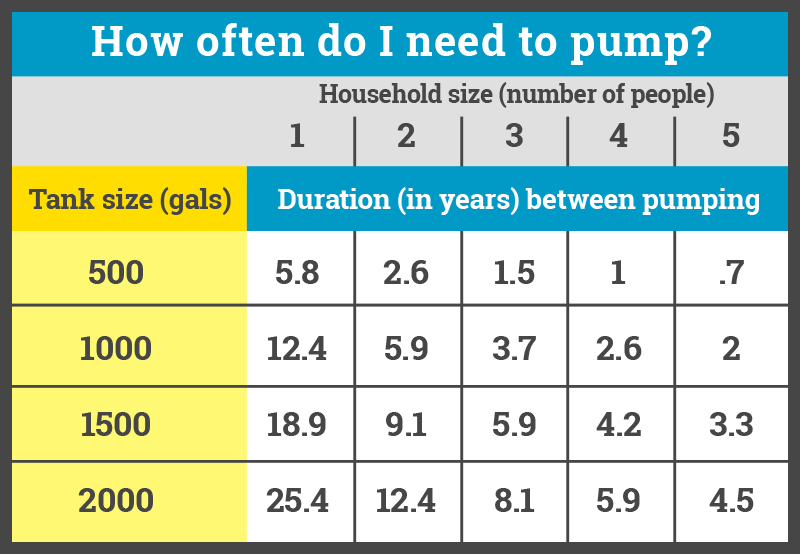
Signs You Need Pumping or Service Now
Your septic tank might not send you a polite reminder — but it does send clues. If you notice slow drains, unpleasant odors near your yard or drains, or soggy spots around your property, these could all mean your septic tank is overdue for service.
Watch for these signs that your tank needs attention:
- Slow drains throughout the house
- Gurgling sounds in toilets or pipes (possible early clog — check with camera inspections)
- Sewage smell around the yard or near drains
- Patches of grass that are unusually lush or soggy above the drain field
- Backup in sinks or tubs (may need emergency septic pumping or drain cleaning)
If any of these sound familiar, call your local septic pro immediately. It’s always cheaper to pump your septic tank than to replace a ruined drain field.
Check our Google Reviews to see how quickly we’ve helped other Long Island homeowners get their systems running again.
Inspection vs. Pumping vs. Cleaning — What Do You Need?
| Feature | Inspection | Pumping | Cleaning |
| What it is | A check-up for your septic system. Measures sludge and scum, checks the tank and drain field. | Removing waste, sludge, and scum from the tank. | Deep cleaning of tank, pipes, or drain field. Gets rid of grease, debris, and hardened buildup. |
| When you need it | If your tank hasn’t been checked in a while or before selling/buying a home. | When solids are near the outlet or the tank is full. | If drains are slow, you notice backups, or there’s a bad smell. |
| How often | Every 1–3 years, depending on tank size and household use. | Usually every 3–5 years; sooner for big families or small tanks. | Only when problems show up; not every system needs it regularly. |
| Benefits | Finds problems early, saves money on repairs, keeps system safe. | Clears stubborn clogs, improves system flow, and fixes hard-to-reach buildup. | Clears stubborn clogs, improves system flow, fixes hard-to-reach buildup. |
| Limitations | Doesn’t remove waste or clean pipes. | Only removes solids; won’t clear pipes or stubborn debris. | Can cost more; may need special tools or equipment. |
Simple Tip:
- Inspection = system check-up
- Pumping = routine cleaning
- Cleaning = deep fix for big problems
How Much Does Septic Tank Pumping Cost in the U.S.?
For most homeowners, you’re looking at somewhere between $250 and $600. If I had to pick one number, I’d say $400 is a solid average. But your price? Well, that’s personal. It’s like asking how much a grocery trip costs. It all depends on what’s in your cart.
Here’s what really decides your price tag:
First up, your tank’s size. A compact 750-gallon tank is a lighter lift. But a 1,500-gallon giant? That’s a bigger job with a bigger price.
Then there’s the “hide and seek” factor. Is your tank lid easy to find, or is it playing buried treasure under your lawn? If the crew has to go digging for it, that’ll add to your bill.
Your location matters, too. Just like gas prices, service costs change from one area to another.
And let’s be honest about your tank’s condition. If it’s been a decade since the last pump, that stubborn sludge takes more work to clear. Heavy garbage disposal use or a full house also means your tank fills up faster.
Here’s a simple reference for typical tank sizes and cost ranges:
| Tank Size (gallons) | Approximate Cost Range |
| ~750 gallons | $175–$300 |
| ~1,000 gallons | $225–$400 |
| ~1,250 gallons | $275–$500 |
| ~1,500 gallons | $345–$600+ |
DIY Maintenance & Monthly Checks You Should Know
You don’t need to be a pro to protect your septic system. With a few simple habits, you can spot trouble early and avoid disasters. Think of it as giving your system a regular health check. A septic maintenance checklist can help you stay on track and make sure nothing gets overlooked.
Your Monthly “Septic Scan” (It takes 5 minutes):
- The Sniff Test: Walk past your drain field. Catch a whiff of something foul? That’s not just a bad smell. It’s a red flag.
- The Puddle Patrol: After it hasn’t rained, check for wet, soggy areas or grass that’s suspiciously lush. Your drain field shouldn’t look like a marsh.
- The Drain Test: Is water taking its sweet time going down the sink or toilet? Strange gurgling sounds? Your pipes are trying to tell you something.
Your Daily “What Not to Flush” Rule:
This is the golden rule of septic care. Your system is designed for human waste and toilet paper, that’s it. Everything else (wipes, floss, feminine products, cooking grease) is an enemy. Treat your toilet like anything but a trash can.
The One Job You Should NEVER Do Yourself:
We know you’re handy, but never open the septic tank lid. Toxic gases can be lethal in seconds. That’s a job strictly for the professionals with the right training and equipment.
How to Choose a Professional Septic Service
When you’re ready to hire a septic service provider, keep these factors in mind:
- The company is licensed and insured in your state.
- They can locate your tank, provide riser installation if needed, and pump the tank fully (not just partially).
- They provide a written service report detailing sludge/scum levels, tank condition, date next recommended service. The EPA recommends keeping this record. Environmental Protection Agency
- Ask about waste disposal methods (where the sludge is taken).
- Ask for references/reviews, especially local to your area.
- Make sure the access to the tank is clear (riser present) and ask whether they will install one if needed (makes future services cheaper).
- Check pricing and transparency: Get a quote in writing, ask if the price includes travelling time, pump-out, and clean-up.
- Consider scheduling service before you experience any problems. Knowing your septic system servicing frequency helps you schedule maintenance proactively and avoid costly backups.
Local Rules & Inspection Requirements
What goes into your tank doesn’t just disappear. On Long Island, it can directly impact our drinking water and beautiful shorelines — which is why proper septic maintenance and pumping is so important.
Suffolk County has rolled out some important new standards. If you’re selling your home or doing major work, you’ll probably need to upgrade to a cleaner, nitrogen-reducing system. Yes, it’s an investment, but there’s good news — grants and rebates can significantly lighten the load.
Selling your house? In both Nassau and Suffolk, a passing septic inspection is non-negotiable. It’s a standard part of the home-selling process that keeps everyone protected. Knowing your inspection frequency helps you plan ahead and avoid surprises during a sale.
Your local health department is your main contact. In Suffolk, that’s the Suffolk County Department of Health Services. In Nassau, it’s the Nassau County Department of Health. They’re the ones who issue permits and have the final say — but if you need help navigating local codes or septic system upgrades, our team can guide you through the process.
FAQs
Q1: How frequently should a septic tank be pumped?
For most households, pumping is needed about every 3 to 5 years. Larger families or smaller tanks may need it more often.
Q2: Does using a garbage disposal affect pumping schedules?
Yes. Using a garbage disposal adds extra solids to your tank, which can shorten the time between pumpings.
Q3: What happens if a septic tank isn’t pumped on time?
If a tank isn’t pumped, solids build up, which can cause backups, slow drains, foul odors, and even expensive drain-field damage.
Q4: Can I pump my septic tank myself?
It’s not recommended. Septic pumping requires special equipment and proper disposal of waste. Hiring a licensed professional is safer and ensures compliance with local rules.
Bottom Line
So, we’ve walked through the big question: how often to pump a septic tank. It really comes down to your home’s routine — how many people live there, what goes down the drains, and how often you maintain your system.
Knowing what to do is one thing. Getting it done right is another. That’s where a reliable Long Island septic service team makes all the difference.
Need a hand with your septic system? Sewer Tech LI is right here in your neighborhood — proudly serving homeowners across Suffolk County and surrounding Long Island areas. Our local technicians provide fast, clean, and professional septic pumping, inspections, and repairs.
Check out our Google reviews to see why Long Island homeowners trust Sewer Tech LI for dependable, affordable service.
Find Us Here:



